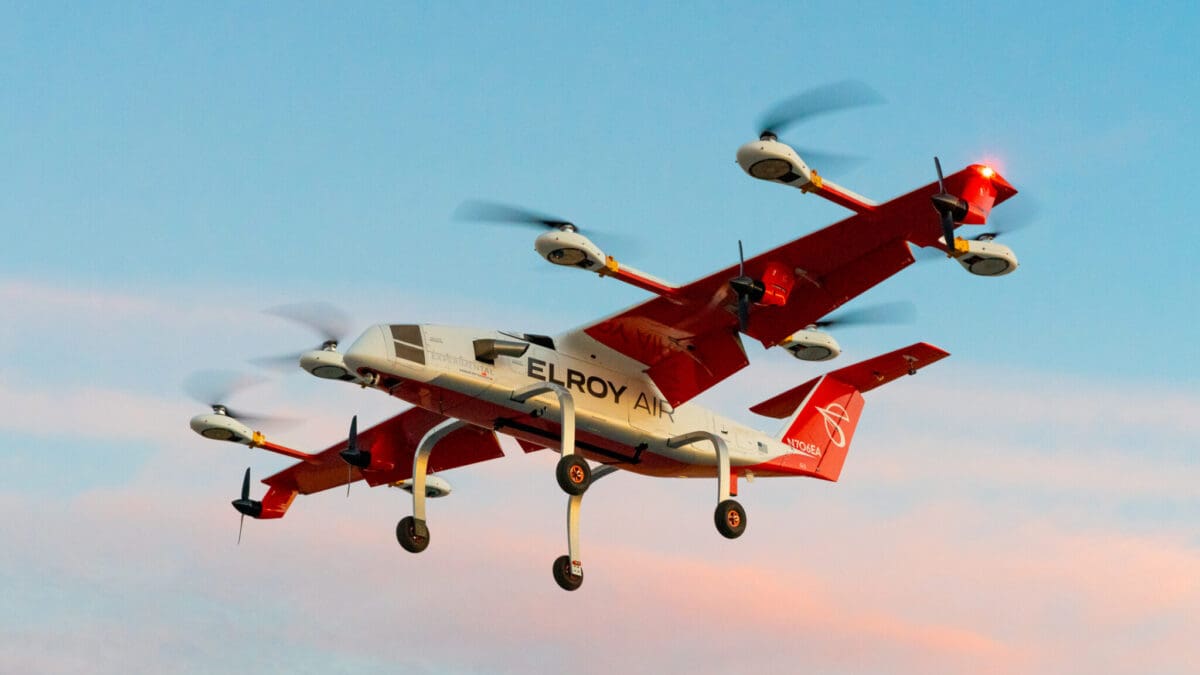Business
Air taxis, delivery drones: Utah sets out to build ‘advanced air mobility system’ by 2034

Pictured is Elroy Chaparral’s autonomous electric vertical take-off and landing aircraft for middle-mile logistics, humanitarian aid shipping, and military resupply. A new public-private partnership in Utah called Project Alta aims to transform transportation with autonomous passenger vehicles and drone deliveries in Utah by 2034. Photo: Courtesy of Elroy Chaparral
Project Alta, a partnership with Governor’s Office, UDOT, Utah Inland Port Authority and 47G, seeks to transform travel — and package delivery — in 10 years
By: Katie McKellar, Utah News Dispatch
It may sound like something out of the “The Jetsons,” but Utah visionaries insist flying “air taxis” — think Uber but in the sky, via electric autonomous aircraft — are a reality on Utah’s horizon.
Perhaps, even by 2034.
Utah Gov. Spencer Cox joined a news conference Thursday with Utah tech and business leaders to launch a new public, private partnership called “Project Alta,” an acronym for Air Logistics Transportation Alliance.
At the helm of the initiative is 47G, formerly known as the Utah Aerospace and Defense Association, a network of over 120 aerospace, defense and cyber companies and 20 academic institutions working to innovate in the three sectors.
As part of Project Alta, 47G is partnering with the Utah Governor’s Office, the Utah Department of Transportation, the Utah Inland Port Authority and other industry partners with a mission to establish an “advanced air mobility” system for Utah.
The group has been tasked with creating a new air transportation system in the state that could revolutionize how Utahns travel and how packages are delivered to their doorsteps — all by 2034.
“We know that we can’t continue to add lanes to our freeways” as Utah continues to grow, Cox said at Thursday’s news conference outside the West Valley City-based center of research and technology for Hexcel, an advanced composites technology company that supplies carbon fiber for air taxis made by Archer Aviation.
Project Alta — with a goal that would align with Utah’s chance to host the 2034 Olympic Winter Games — brings “an opportunity for us to reimagine what transportation can be here in our state,” the governor said.
“We can’t keep widening,” he said. “But we can start going vertical. And that’s exactly what we’re going to do.”
Challenges ahead include not just developing the technology, but also building infrastructure and shaping local and federal regulations to help pave the way for the new modes of transportation, which would require creating an entirely new system of air pathways for drone deliveries, and eventually autonomous passenger vehicles, or air taxis.
Drone delivery company Zipline displays a model during a press conference announcing the launch of Project Alta outside Hexcel’s center for research and technology in West Valley City, Utah on May 30, 2024. (Katie McKellar / Utah News Dispatch)
What’s ahead for Project Alta
Chris Metts, a former senior-ranking Federal Aviation Administration official and now executive director of Project Alta, told Utah News Dispatch the project will begin with a safety-focused “phased approach,” starting first with expanding small package drone deliveries, then working up to larger cargo and, eventually, people.
Today, drones are already delivering packages to Utahns, but in limited areas. In 2022, Walmart launched a drone delivery pilot program in Lindon and Herriman. Later that same year, Intermountain Health and drone company Zipline launched a program to deliver prescriptions and medical products
directly to certain yards in the Salt Lake Valley area.
“Meanwhile, we’ll be watching what happens in the rest of the world,” Metts said. “We’ll be improving the technology, we’ll be partnering with the electric vehicles takeoff and landing companies to try to expand the abilities and to take advantage of the approvals they get in other parts of the country to bring those services here.”
Additionally, he said “we’ll be focusing on first-responder access,” like transporting equipment and eventually transporting first responders themselves.
The ultimate goal is passenger transport — and while it may be a ways off, especially considering the work ahead for federal regulations — Metts said it’s “not unrealistic at all.”
“If you talk to the manufacturers of those aircraft, they are moving down that road now,” he said.
Aerial vehicles are already planned to launch in cities like Dubai, London and New York, as reported by National Geographic. Metts pointed to areas like Dubai, where regulators are “a little more willing to move the technology forward,” he said.
Launch and landing locations are still limited and “the technology of how far they can go is still limited,” but he said “eventually what you’ll probably find is there will be communities that don’t have passenger air traffic that will eventually be able to develop passenger air traffic.”
In Utah, “we are reshaping our local communities … in a way that will have transportation hubs that will likely include some form of advanced air mobility,” Metts said, adding that technology could range from electric vehicles to advancement in existing technologies like helicopters.
“It will be a step at a time — a phase at a time — emphasizing, once again, safety and economic viability to make this be something that is supported by the community and supportable by the community,” Metts said.
Paul Damron, UDOT advanced air mobility manager, said in a prepared statement that Utah’s transportation officials will work closely with 47G to create a “well-functioning transportation system in the air that connects seamlessly with the transportation system on the ground.”
“Imagine a world where you can hop on an air taxi and travel anywhere along the Wasatch Front in 20 minutes,” he said.
A legislative mandate on 47G
Cox said he and the Legislature have “given 47G the mandate to lead the state’s advanced air mobility strategy,” which he and other business leaders depicted as a future of drones delivering packages — including life-saving medicine and care — as well as electric air taxis that would be quieter and more environmentally friendly than helicopters.
This year, more than $3 million in state funding has been set aside to advance Utah’s air mobility goals.
The 2024 Utah Legislature appropriated $1.15 million in one-time state funding along with intent language included in the spending bill HB3 that the money go toward an “advanced air mobility center of excellence and ecosystem accelerator” that will be used by 47G “to support the state’s air mobility efforts and foster growth through services to companies competing in this space in partnership with the Utah Department of Transportation, Governor’s Office of Economic Opportunity, Utah Inland Port Authority, and private business.”
Lawmakers told 47G to use the money to foster more investment in the industry, as well as work with the state’s workforce development programs to jumpstart the project.
“The Legislature intends that 47G use the funds to assist in matchmaking with larger defense contractors and work in coordination with the Utah Innovation Lab to develop an investment ecosystem of venture capital and private equity investors and work with Talent Ready Utah to support workforce needs,” the bill states.
In addition to the $1.15 million set aside for the initiative, the 2024 Utah Legislature also appropriated roughly $1.9 million for the Utah Department of Transportation to set up a “test site” for advanced air mobility, Matthew Maas, director of UDOT’s division of aeronautics, told Utah News Dispatch after Thursday’s news conference.
When asked about the appropriations from the Legislature, Aaron Starks, 47G president and CEO, told Utah News Dispatch “we take a lot of pride in knowing that the governor’s office and the Legislature is partnering with us to advance the economy.”
“Any capital put into 47G is then deployed into longer-term economic initiatives,” Starks said.




















